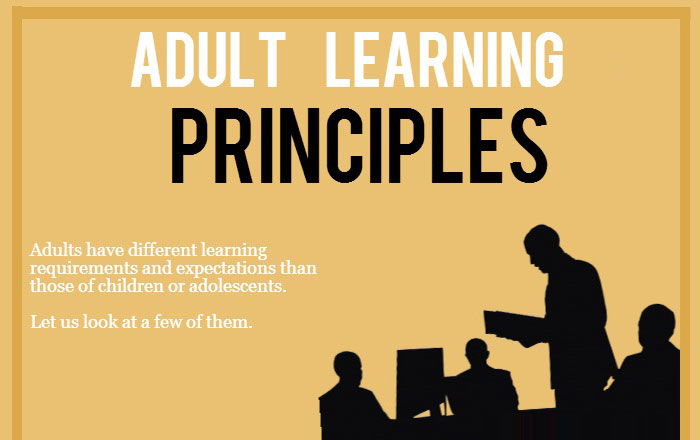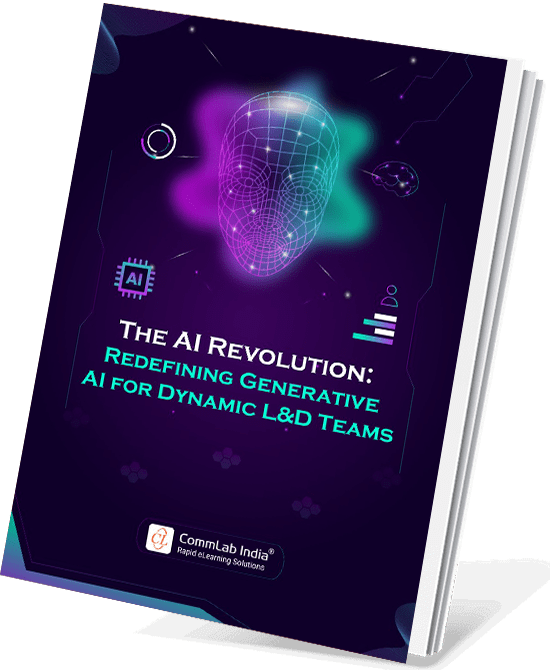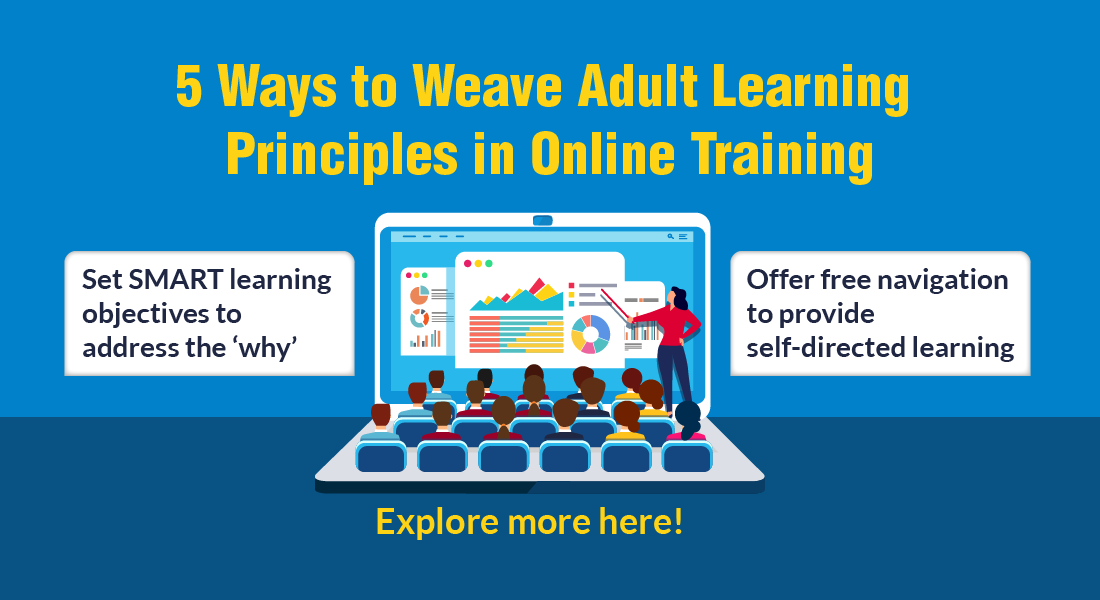A Complete Guide on Adult Learning Principles

“Learn continually – there is always ‘one more thing’ to learn!” says Steve Jobs. And we, as training managers, say “Amen!”. The day we humans stop learning, it would be the end of life, there would be neither more creativity nor knowledge. Thus, learning is a continuous process in life that distinguishes us from every other living being. However, the science of learning is not the same for all of us. So, while introducing eLearning in your workplace, it is necessary to base them on a good understanding of adult learning principles. And that is what this blog is all about – the intricacies of adult learning principles.
→ Download eBook: Impact of Generative AI on L&D Teams
Table of Contents
- How Different is Teaching Adults from Teaching Children?
- What Are the 6 Adult Learning Principles for Effective Online Training?
- How to Incorporate Adult Learning Principles in eLearning Courses?
How Different is Teaching Adults from Teaching Children?

Adult education, officially known as “Androgogy”, is well-defined as the set of definite abilities and related knowledge geared towards the educational development of adults. On the other hand, ‘Pedagogy’ is the science and art of teaching children.
Adults perceive things differently from children. Unlike children, adults know what they want, what their interests are, and what is expected out of them. This helps them to choose subjects that enhance their knowledge and skills. They choose to learn independently and hence do not require boring classroom lectures. They learn at their own pace. They learn more efficiently when they have a strong motivation from within.
Adults bring their slice of knowledge to learning. This enormous experience is a supply for themselves and for other beginners, and it gives richer implication to new ideas, thoughts and services. Therefore, while teaching adults, the instructor should emphasize more on case studies, scenarios and discuss more live examples. This way learning is fun and the experience richer.
Malcolm S. Knowles, theorist of adult education identified six principles that shed light on how adults learn.

Redefining Generative AI for Dynamic L&D Teams
Discover how Generative AI is breaking boundaries and empowering L&D Teams
- Why leverage Generative AI for L&D?
- What training managers should know about generative AI
- Ethical conundrums for Generative AI: Use cases
- Future prospects of Generative AI
What Are the 6 Adult Learning Principles for Effective Online Training?
The 6 principles of adult learning proposed by American adult educator, Malcolm Knowles, lay the foundation for effective online corporate training.
The Principles of Adult Learning at a Glance
Principle 1: Adults have a ‘need to know’ why they should learn something
Principle 2: Adults have a deep need to be self-directing
Principle 3: Adults have a lot of previous knowledge and experience that can form the base for new learning
Principle 4: Adult learners’ readiness to learn plays an important role
Principle 5: Adults learn better if they believe the new learning is going to help them PERFORM their jobs better or SOLVE a problem
Principle 6: Adults are motivated to learn by both extrinsic and intrinsic motivatorsLet us understand what they are and how you can use them in your online training.
Principle 1: Adults have a ‘need to know’ why they should learn something
You receive an e-mail from your L&D department on a Monday morning that you are enrolled for a new training program. What is the first thing you do? Look for the ‘What’s in it for me’, right? That’s because we as adults have a need to know why we should learn something and how it is going to make a difference in our lives.
When it comes to corporate training, your employees would want to know the utility and relevance of the training program with respect to their jobs. So, while designing an eLearning course, it is essential to address the ‘Why’ factor. This answers their ‘What’s in it for me?’ question and motivates learning.
The best way to go about it is through well-defined, performance-based learning objectives that inform learners what they will be able to do after they finish the course. Also, ensure that you set SMART learning objectives.

You can be creative while stating the learning objectives – pose interesting and thought-provoking icebreaker or rhetoric questions to pique learners’ curiosity.
Principle 2: Adults have a deep need to be self-directing
Teaching children is all about encouraging them to explore new things. You need to handhold them through the entire process to ensure learning. On the contrary, adult learners learn better when they are in charge of their own learning, when the learning is self-directed and self-paced.
So, while designing your corporate eLearning courses, try not to tie down learners with restrictions. Go for a learner-friendly intuitive GUI (Graphic User Interface), offer them free navigation through the course, and allow them to skip content if they wish to do so. Also, ensure your courses are multi-device, multi-browser compatible and host them on your LMS (Learning Management System) to ensure anytime, anywhere access.
Principle 3: Adults have a lot of previous knowledge and experience that can form the base for new learning
Adults are not ‘blank slates’ – they already have a lot of knowledge, values, and perspectives about many things. They build new learning on their existing knowledge and so, it is extremely important to connect the current information to their prior knowledge.
You can use tests and eLearning assessments to get an idea about the learners’ existing knowledge on the topic. Give them the freedom to skip a module or a topic that they already know about, while also allowing them to take up topics, units, or modules they are interested in learning for a better learning experience. With that said, it is important to ensure that the topics picked by learners align with their roles and responsibilities.
Principle 4: Adult learners’ readiness to learn plays an important role
Unlike children, you can’t really tell an adult learner to simply sit down and learn something. Adults have their own way to prepare themselves to learn something often considered as readiness to learn. Mostly, adult learners are motivated to learn when they see a direct connection between the new information and how it will benefit them in achieving their current or future goals.
Principle 5: Adults learn better if they believe the new learning is going to help them PERFORM their jobs better or SOLVE a problem
The need to solve problems is a major factor that drives adult learners. They look for relevance in their learning rather than taking up any random course. They are keenly interested to learn something that can help them solve their day-to-day work issues and make their work as well as personal lives easier.
So, design eLearning courses in a manner that’ll equip the learners with practical skills and knowledge that allows them to solve their real-life tasks/problems efficiently. Also, focus on experiential learning to boost employee performance. The best way to do that is through case studies, simulations, and branching scenarios.

Principle 6: Adults are motivated to learn by both extrinsic and intrinsic motivators
All of us love to be appreciated and acknowledged. And that includes your adult learners too.
Both extrinsic and intrinsic motivators can be used to motivate your learners to enroll and complete the training program. Certificates, pay hikes, rewards, recognition, and promotions are some of the extrinsic motivators for adult learners. Adults also learn better if they feel the learning is going to boost their self-esteem (intrinsic motivator) and help them in their career growth.
You can use gamification elements in your eLearning courses to motivate learners, enhance learner engagement, and foster learning.

How to Incorporate Adult Learning Principles in eLearning Courses?
As we’ve seen in the earlier section, Malcolm Knowles developed a set of core andragogical principles. These adult education principles serve as a foundation for high-impact, learner-centric eLearning design and development. They help instructional designers and eLearning developers to understand clearly what an adult learner needs and create a learning experience which promotes better understanding of concepts, learner engagement, and knowledge retention. Given the importance of adult learning principles in designing effective instructional designs and eLearning courses, here’s a quick recap of the andragogical principles.
The principles of adult learning state that adults:
- Are self-directed
- Want the learning to be relevant and task-oriented
- Are goal-oriented
- Bring prior knowledge and experience to the learning activity
- Learn when they are motivated
Now we will see three ideas for incorporating adult learning principles into eLearning courses to make learning better and to bring a behavioral change in the learner.

1. eLearning Courses Should be Self-directed
Adults prefer to be self-directed as they wish to control their learning, learn at their own pace, and set their priorities accordingly. For example, consider you are stuck up in a mirror maze for an hour. You’re dehydrated and trying your best to make an exit as soon as possible. At this point in time, your only thought is of exiting that place. So, you will think logically and try to come out of that maze even if you don’t have any external help. Applying the same logic in learning, every adult has a deep need to be self-directed.
Generally, people learn more and better when they learn alone and they will be more attuned toward the learning outcomes. To design eLearning accordingly:
- Allow learners to take the trainings based on their preferences.
- Provide them job-aids and other training material after the course.
- Provide them courses which have learning strategies that help them get involved in the content such as problem-solving scenarios, guided approach, gamification, simulations, etc.
- Collect and try to incorporate learners’ inputs.
2. Make eLearning Courses Relevant and Task-Oriented
In our school days, we learned topics which were boring and didn’t interest us at all. But we had to learn them in order to complete our academic life. Adults on the other hand, learn only what is useful in their professional or daily lives. They prefer training courses that are relevant to their current roles and responsibilities or will help them progress in their career.
For example, compliance training or safety training is a must for all employees. Whereas assigning a course on conflict resolution in customer service to an IT guy doesn’t make sense. So, your training should be related to the job profile of the learner.
To design eLearning accordingly:
- Focus on the training material the learner needs to know and leave additional material.
- Design learning activities that are task-based and emphasize problem-solving.
- Present learning objectives clearly to learners.
- Connect the learning with the real-world examples that are useful to their roles.
3. Integrate Knowledge and Experience in the eLearning Activity
As adult learners are more mature, they typically have a wide range of knowledge and experience. For example, where you are trying to say something that is correct, but not in accordance with the other person’s views, they may not receive it the right way. It is the mindset of every adult and his experiences guide them in determining what is right or wrong.
To design eLearning accordingly:
- Focus on the connectivity of your training material with their previous experiences.
- Do remember that every employee has a different mindset, so be receptive to all.
- Provide them the opportunity to give feedback on their training experience.
There you have it! These are some of the effective ways by which you can incorporate adult learning principles in eLearning courses.

Redefining Generative AI for Dynamic L&D Teams
Discover how Generative AI is breaking boundaries and empowering L&D Teams
- Why leverage Generative AI for L&D?
- What training managers should know about generative AI
- Ethical conundrums for Generative AI: Use cases
- Future prospects of Generative AI
What Is the Checklist to Ensure eLearning Courses Follow Adult Learning Principles?
Here’s a handy checklist that would assist you in ensuring your learner-centric eLearning courses follow adult learning principles.

1. Does Your Course Address the Learning Needs?
Principle: Adult learners need to know WHY they should learn something.
Adults get interested in a course when they know the reason and benefits of taking the course. So, make sure your course develops a ‘need to know’ among the learners before they undertake it. This can be achieved by telling your learners what they will be able to do after completing the course, by setting well-defined learning objectives.
For example, if the course is for the sales reps on communication skills, at the beginning of the course you can tell the leaners- at the end of the course you will be able to:
- Identify different types of communication
- Decide when each method of communication is most suitable
- Rightly use non-verbal communication skills
- Recognize irate customers
You can also build curiosity among learners by giving them ice-breaker questions. For example:

Thus, this good practice of presenting the objective will give the learner an outline preview of what they will learn and how the learning will be conducted.
2. Is the Course Self-Directing?
Principle: Adults want to learn in their own way and at their own speed. They have a very sharp need to be SELF-DIRECTING.
Adults have a deep need to be self-directing. So, check whether your course permits learners to learn in their own way and at their own pace, i.e. supervise, motivate and adjust their own learning. Let your course be built on instructional design strategies that help learners see themselves as being self-directed learners.
In addition to this, allow your learners to navigate freely through the eLearning course. Give them the liberty to skip topics that they already know or not engage in an eLearning activity that is irrelevant to their work profile. These aspects promote accountability and decision-making skills among the employees.

Redefining Generative AI for Dynamic L&D Teams
Discover how Generative AI is breaking boundaries and empowering L&D Teams
- Why leverage Generative AI for L&D?
- What training managers should know about generative AI
- Ethical conundrums for Generative AI: Use cases
- Future prospects of Generative AI
3. Does the Course Acknowledge Prior Knowledge and Experience of Learners?
Principle: Adults have a lot of knowledge, experience, beliefs and values about a great many things. They build new learning on top of their already EXISTING KNOWLEDGE.
Why do you think children are successful learners? This is because they do not have previous knowledge about anything and their mind, according to the theory of “tabula rasa” is a “blank slate”. Hence, the way they learn is very different from adults, who have a greater volume and different quality of experience than children.
Adults build their new learning over their already existing knowledge, beliefs, years of experience in the industry and values. Thus, acknowledge their prior knowledge and expertise in the industry with “Do you know?” questions and scenarios based on the topics they already know and help them build the new knowledge over it.
For example, in a drug related course on insomnia, let us assume the learners know what insomnia is and its causes. At the beginning of the course you can ask them questions such as:
- Define insomnia
- Explain the causes and types and insomnia
Once learners answer these questions, tell them, since they know the answer to these questions, they will learn about the different treatment options for insomnia. This can help build interest and enthusiasm among learners to learn more about the subject. By blending instructional design principles, this approach sparks curiosity and inspires a genuine passion for the topic.
4. Is the Course Performance-Oriented and Problem-Centered?
Principle: Adults will be interested to learn if they believe that the new learning will HELP them in their daily lives, PERFORM their jobs better or SOLVE a problem.
Adults become ready to learn when the learning program looks relevant to their life and offers them an opportunity to perform more effectively and satisfyingly. Additionally, adult learners are better oriented toward problem-centered learning than content.
Rather than learning a random concept, they look for solutions to problems, tasks, and situations they regularly face at the workplace. So, make sure your course is going to bridge the existing skill gap and help learners perform more effectively by providing them performance-oriented and problem-centered courses.
For example, at the beginning of the course you can state a problem that hinders the performance level of the employees quite frequently at the workplace and then tell them that by the end of the course, they will be able to come up with a remedy or solution for that particular challenge.
Similarly, make sure the course addresses your employees’ problems at the workplace. State those problems and tell them the eLearning course will help in resolving those. The below given image is an example of a problem-centered course.

5. Does eLearning Content Incorporate the Extrinsic and Intrinsic Factors of Motivation?
Principle: Adults are motivated by external REWARDS such as increase in ages, promotions, etc. They will also learn if they think that it will increase their self-esteem, influence and growth.
Adults look for both extrinsic and intrinsic triggers to indulge in learning. They learn if they feel the eLearning course will offer them extrinsic factors such as better working conditions or rewards in the form of an increase in wage and promotion.
Adults also learn if they think the course will increase their influence, self-esteem, and growth. What more to say, everyone feels better if you treat them with respect and acknowledge their work.
eLearning is the best choice to boost these factors of motivation among learners. It lets you tap into the child in every learner by inserting gamified assessments in the course. Games and their scores motivate learners like nothing else.
- You can fuel a learner’s intrinsic motivation and boost the competitive spirit by adding gamified elements such as scores and points.
- As an extrinsic factor, you can use leaderboards at the end of an assessment to boost enthusiasm among the learners. Certification courses and their scores are also great motivators.
Ready to level up your eLearning? Watch the video below to know about the top 5 effective gamification resources.
Thanks to Malcolm Knowles, who brought the art and science of how adults learn to life by developing the core learning principles for adult learning. These adult learning concepts have helped us understand what adult learners want. Thus, when you create a learner-centric eLearning, address each of the above questions to check if your adult learning principles are well in place.
The Bottom Line
Designing eLearning courses based on the adult learning principles can be really instrumental in enhancing learning and boosting employee performance. Now that you are aware of the nuances of andragogy, are you ready to implement them in your training program? In today’s digital era, you can even leverage Artificial Intelligence to curate training courses that align well with the adult learning principles. Wondering how? Check out our latest eBook on Generative AI for L&D teams now!
Editor’s note: This post was originally published on April 24, 2014 and has been updated for comprehensiveness.





